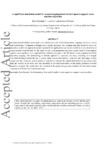Mostrar o rexistro simple do ítem
A rapid flood inundation model for hazard mapping based on least squares support vector machine regression
| dc.contributor.author | Bermúdez, María | |
| dc.contributor.author | Cea, Luis | |
| dc.contributor.author | Puertas, Jerónimo | |
| dc.contributor.other | Enxeñaría da Auga e do Medio Ambiente (GEAMA) | es_ES |
| dc.date.accessioned | 2024-01-25T19:49:30Z | |
| dc.date.available | 2024-01-25T19:49:30Z | |
| dc.date.issued | 2019 | |
| dc.identifier.citation | Bermúdez, M., Cea, L., & Puertas, J. (2019). A rapid flood inundation model for hazard mapping based on least squares support vector machine regression. Journal of Flood Risk Management, 12, e12522. https://doi.org/10.1111/jfr3.12522 | es_ES |
| dc.identifier.uri | http://hdl.handle.net/2183/35170 | |
| dc.description | Versión aceptada de https://doi.org/10.1111/jfr3.12522 | es_ES |
| dc.description.abstract | [Abstract:] Two-dimensional shallow water models are widely used tools for flood inundation mapping. However, even if High Performance Computing techniques have greatly decreased the computational time needed to run a 2D inundation model, this approach remains unsuitable for applications that require results in a very short time or a large number of model runs. In this paper we test a non-parametric regression model based on least squares support vector machines as a computationally efficient surrogate of the 2D shallow water equations for flood inundation mapping. The methodology is initially applied to a synthetic case study consisting of a straight river reach flowing towards the sea. A coastal urban area is then used as a real test case. Discharge in three streams and tide levels are used as predictor variables to estimate the spatial distribution of maximum water depth and velocity in the study area. The suitability of this regression model for the spatial prediction of flood hazard is evaluated. The results show the potential of the proposed regression technique for fast and accurate computation of flood extent and hazard maps. | es_ES |
| dc.description.sponsorship | This work was financially supported by the Spanish Ministry of Economy and Competitiveness (Ministerio de Economía y Competitividad) within the project “CAPRI: Probabilistic flood prediction with high resolution hydrologic models from radar rainfall estimates” (reference CGL2013-46245-R). María Bermúdez gratefully acknowledges financial support from the Spanish Regional Government of Galicia, Postdoctoral Grant Program 2014 (grant reference ED481B 2014/156-0) and 2018 (grant reference ED481B 2018/016). | es_ES |
| dc.description.sponsorship | Xunta de Galicia; ED481B 2014/156-0 | es_ES |
| dc.description.sponsorship | Xunta de Galicia; ED481B 2018/016 | es_ES |
| dc.language.iso | eng | es_ES |
| dc.publisher | Wiley | es_ES |
| dc.relation | info:eu-repo/grantAgreement/MINECO/Plan Estatal de Investigación Científica y Técnica y de Innovación 2013-2016/CGL2013-46245-R/ES/CALCULO PROBABILISTICO DE INUNDACIONES CON MODELOS HIDROLOGICOS DE ALTA RESOLUCION ESPACIAL A PARTIR DE ESTIMACIONES DE PRECIPITACION DE RADAR | es_ES |
| dc.relation.uri | https://doi.org/10.1111/jfr3.12522 | es_ES |
| dc.subject | Flood hazard | es_ES |
| dc.subject | Flood inundation | es_ES |
| dc.subject | Iber model | es_ES |
| dc.subject | Shallow water equations | es_ES |
| dc.subject | Support vector machine | es_ES |
| dc.title | A rapid flood inundation model for hazard mapping based on least squares support vector machine regression | es_ES |
| dc.type | info:eu-repo/semantics/article | es_ES |
| dc.rights.access | info:eu-repo/semantics/openAccess | es_ES |
| UDC.journalTitle | Journal of Flood Risk Management | es_ES |
| UDC.volume | 12 | es_ES |
| UDC.startPage | 12522 | es_ES |
| dc.identifier.doi | 10.1111/jfr3.12522 |






